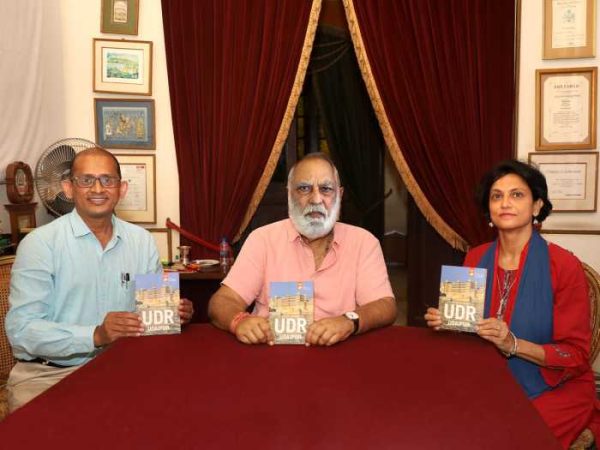
Shriji Arvind Singh Mewar of Udaipur, Chairman and Managing Trustee, Maharana of Mewar Charitable Foundation unveiled the book titled ‘UDR – A Living Heritage Guide’ authored by Dr. Shikha Jain and Dr. Mayank Gupta. Published by Altrim Publishers, supported by Maharana Mewar Historical Publications Trust, a unit of Maharana of Mewar Charitable Foundation (MMCF), The City Palace, Udaipur.
Udaipur is a 16th-century historic city founded as the capital of erstwhile Mewar kingdom by Maharana Udai Singh II. Set in a basin within a network of lakes Udaipur is one of the most picturesque cultural landscapes in the state. The city of Udaipur is strategically located amidst a saucer-shaped basin, surrounded by hills of Aravali Range on all sides; hence the entire city area serves as a good catchment that has facilitated the network of lakes in the city. Formed out of multiple layers of historic fabric, rituals, local crafts, and folk arts- this city is a little piece of paradise set in eastern Rajasthan. The living cultural heritage of Udaipur is extraordinary, surprising, and overwhelming you at each step.
About the book
This guide book on Udaipur will introduce the visitor to the entire range of resplendent art of Mewar and architecture of the city. It covers architectural marvels from across various historical periods, architectural typologies, and artistic styles. The book is divided into two main sections. The first section of the book covers landmarks from the founding of the city, its evolution and growth from the 16th to the 21st century. It also contains an overview of its heritage (tangible and intangible) including lakes and step wells, gates and city walls, forts and palaces, havelis, temples, public buildings, memorials, historic gardens, and various crafts clusters within the city.
The second section of the book focuses on six special itineraries. These itineraries are designed to focus on experiencing the living heritage of Udaipur. Together, the city overview and itineraries are designed to offer an experience of the entire spectrum of crafts and festivals, centuries of historic layers of the urban fabric, iconic monuments and museums, gardens, water bodies and lakes that constitute the Living Heritage of Udaipur.
Key Highlights of the Book
Section 1: The first section also covers the magnificent City Palace Museum with the help of two special itineraries.
-
The first itinerary is about the museum and interior palace space.
• The second itinerary guides the visitor to the city with the lake, temple, and havelis from various vantage points to explicate the city planning.
Section 2: The second section includes six itineraries that are essentially city walks covering various streets and city spaces.
• The first Itinerary in the second section is the Bhattiyani Chohatta to Gangaur Ghat Walk. It
covers the oldest city street of the Bhattiyani Chhohatta along with its havelis, temples, and
shops that lead down to the lake front public space of Gangaur Ghat.
• The second itinerary, Jagat Shiromani Temple-Ghantaghar- Ganesh Ghati- Ambrai Ghat, covers the first significant city temple of Jagat Shiromani located at the main city square. It leads the visitor down through old Udaipur streets to later British Period Square housing the Clock Tower and ending across the lake at the Ambrai Ghat.
• The third itinerary is the Gulab Bagh and Dudh Talai Heritage Walk. It is an experience through the historic gardens of Gulab Bagh with its orchards, two step-wells, and the smaller water body of Dudh Talai next to the Lake Pichola along with a visit to the Vintage Car Museum.
• The fourth one is the Pichola Lake Heritage Trail designed as a boat trail to cover the palaces and ghats along the historic lakefront along with various small and large island palaces within the historic Lake Pichola.
• The fifth itinerary is the Fateh Sagar Trail. It covers the last lake of the city constructed in the early 20th century along with historic gardens, palaces, and crafts areas on the outskirts of the city beyond the city wall.
• Lastly, the sixth itinerary is the Ahar Heritage Walk that covers the archaeological layers of the earliest Ahar settlement in the city. It also includes a visit to the Ahar museum and the royal cenotaph complex of the Sisodia Rajputs who ruled Mewar.
• In addition, there are two entire itineraries to the region’s historic hill fort capitals preceding
Udaipur, Chittorgarh and Kumbhalgarh.
• Collectively, the itineraries are designed to cater to a diverse range of architectural interests and to help prioritize with respect to availability of time. Furthermore, deriving accurate and enhanced information on the exact location of sites included in the guide is now made easier with the option of geo-data, provided in the form of QR codes.
About the Authors
Architect Dr. Shikha Jain has an extensive portfolio on cultural heritage of India that covers Conservation, World Heritage and Museum Planning projects such as the City Palace Museum at Udaipur, largely realised through her organisation DRONAH. As an international expert on World Heritage, she has advised government organisations in Singapore, Malaysia, UAE, Myanmar and UNESCO Offices at Jakarta, Indonesia and Myanmar. She has worked as consultant to the UNESCO New Delhi and, represented Ministry of Culture, India as a Heritage Expert on the UNESCO World Heritage Committee. She is Vice President, ICOFORT, ICOMOS and Advisory Committee Member, MSc. UNESCO C2C at WII, Dehradun.
Dr. Mayank Gupta, born, brought-up and educated in his hometown Udaipur. He has been working with Maharana of Mewar Charitable Foundation since 2003. He has orchestrated and has been an active participant across an array of successful projects like the conservation master plan of The City Palace Museum funded by The Getty Foundation, USA; UNESCO India Office led joint co-operation programme with the City of Strasbourg, France; grant from Ministry of Culture, Government of India. Dr. Gupta is also the Convener of Maharana Mewar Foundation Annual Awards Distribution Ceremony since 2008.
